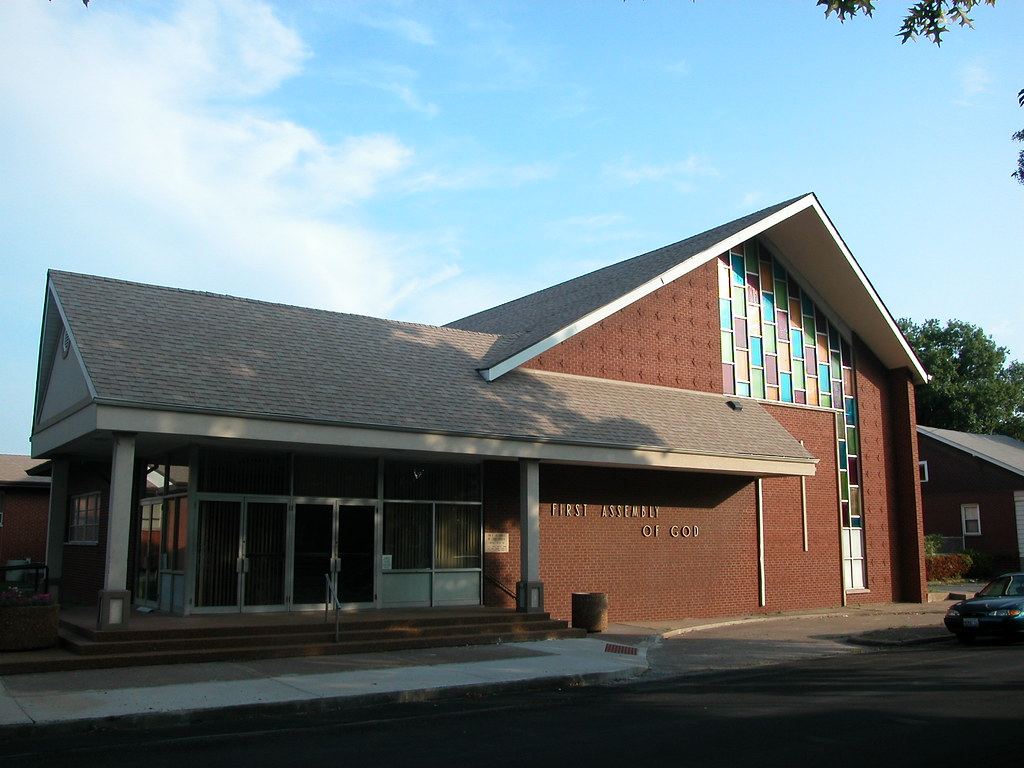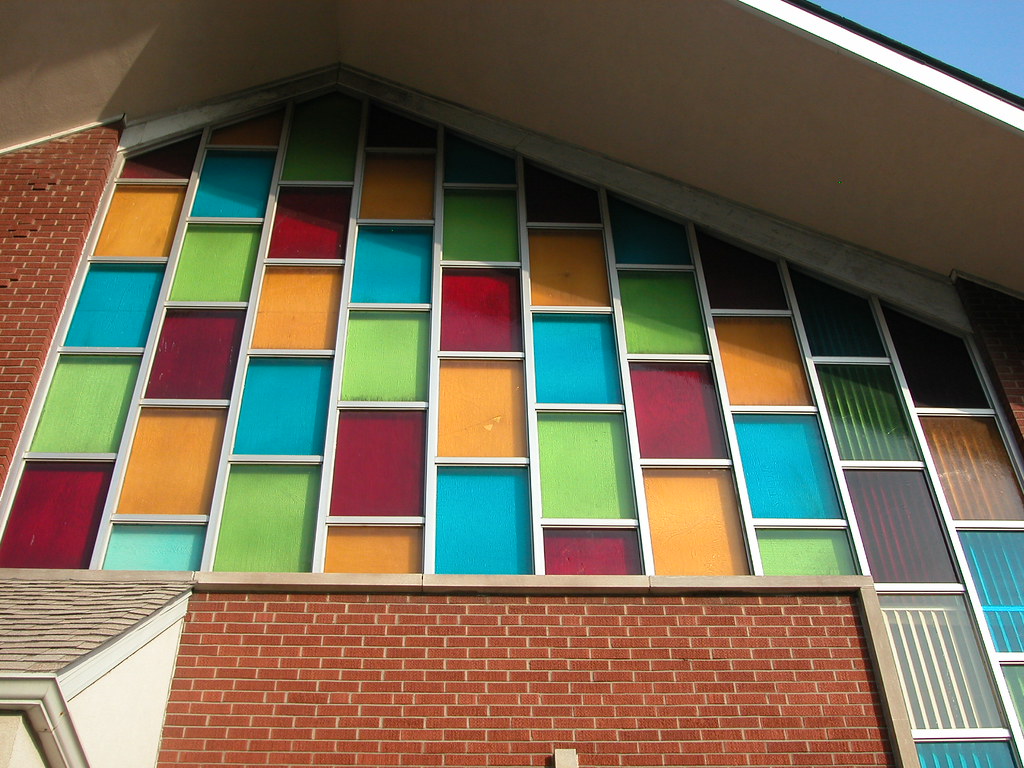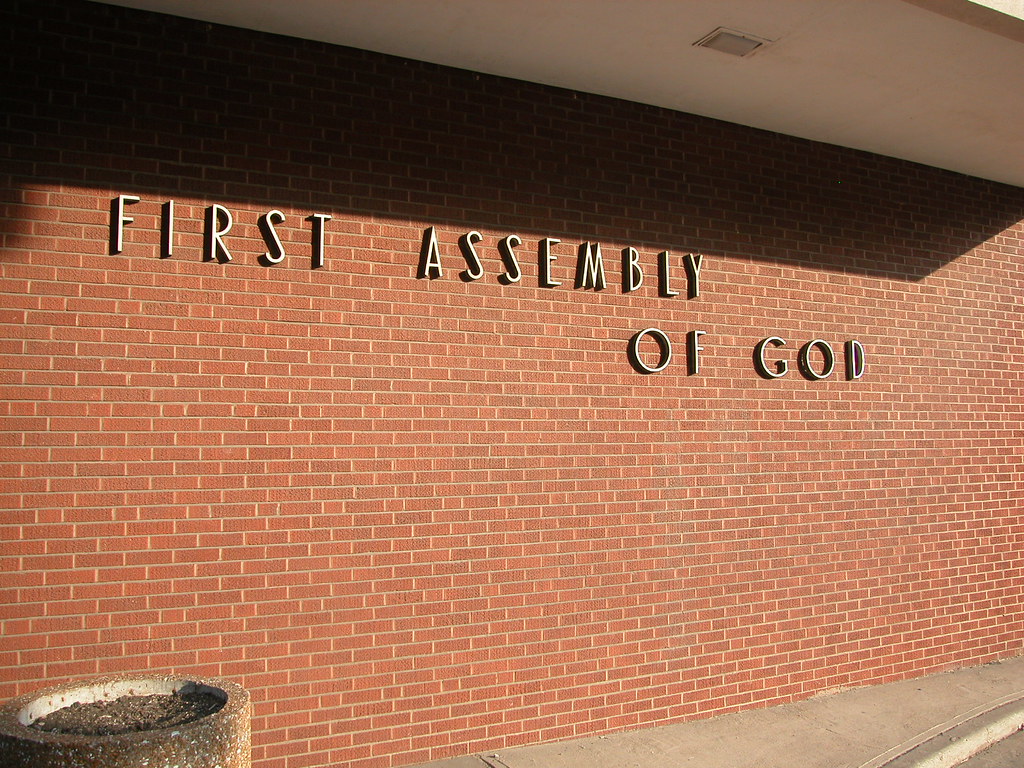 Located at 2334 Grand Avenue in Granite City, Illinois, is the former First Assembly of God Church. While the congregation, which has roots dating back to 1909, has moved to a larger building on Madison Avenue, it still maintains the exuberant mid-century church building.
Located at 2334 Grand Avenue in Granite City, Illinois, is the former First Assembly of God Church. While the congregation, which has roots dating back to 1909, has moved to a larger building on Madison Avenue, it still maintains the exuberant mid-century church building.Basically, this church is the average center-aisle front-gabled church form that has persisted in America since the colonial period. Yet it is adapted to the formalism of its era. The gable is not symmetrical. The entrance is not centered on the gable end but placed to one side on a glass addition.
Most prominent, though, is the use of colored glass. This church comes from a period in the late 1950s through the mid-1960s when modernist architects were abuzz with large, loud color experiments. In 1961, Plaza Square Apartments opened in downtown St. Louis; architects Hellmuth Obata Kassebaum and Harris Armstrong gave each of the six multi-story apartment buildings vertical metal stripes in different vivid, bright colors. Googie designs in restaurants and bus depots abounded. Homes has bright garage doors in green, red, blue and yellow. Young John F. Kennedy was president, the Russian threat seemed diminished and all was well. Why not play with churches, homes, schools and office buildings?
 The architect of this church sure did play. We have a beautiful asymmetrical tapestry of aluminum-framed colored panes on the front elevation and striped of color on the sides. Obviously, the colored panes also provided an economical alternative to stained glass, but in way no less stylish.
The architect of this church sure did play. We have a beautiful asymmetrical tapestry of aluminum-framed colored panes on the front elevation and striped of color on the sides. Obviously, the colored panes also provided an economical alternative to stained glass, but in way no less stylish.The church remains a festive point on a tidy, quiet street of well-kept houses. A steel city, Granite City welcomed modernism with open arms, as evidenced by the iconic Granite City Steel Building downtown. This church is one of the best-kept examples of the mid-century modern period in Granite City.
 |  |
 |  |





9 comments:
As a Granite City native, I am pointing out the first use of the word "exuberant" in connection with a church in Granite City - or any aspect of public life in this scrappy little steel town.
Sadly "exuberant" is used to describe the church architecture and not the congregation. Would of loved to have learned more about their services rather than the use of the early 70's coloring of its panels.
This "you love the buildings more than the people that use them" rap is becoming tedious. Especially so, when Mike's pointing out the small and out-of-the-way joys that surround us.
Hey everyone, stop complaining about the perceived inadequacies of other people's blogs and start your own that addresses what you think is missing from the St. Louis blog scene. That's what I'm trying to do.
No inadequacies here, just interesting discussion about the relationship between buildings and people.
For some, the view from the sreet is fulfillment. For others, understanding the purpose and future of a building relative to the people using it is important.
Different strokes.
Last anonymous hit the nail on the head, except I don't think the two perspectives are mutually exclusive. I just know that since I work on this blog in my spare time, I can't be all things to all people.
Want to know about the congregation? Follow the link that I posted, read the church history and call the pastor. Or stop by a service.
This blog is a guide to the real world, not a substitute.
To Miss Anthrope:
Did you read the post?
Services are held a at another building; this is owned by the church but no longer used.
The post was about _this building_, not the church congregation.
By the way, you can read about services on the church website, which was linked to, if you read the post.
What a fantastic wall of color!
re: miss anthrope's comment... I'm sure Mr. Allen would love to write such a post, and do such in-depth research on the users of every building he's documented. Hell, I feel the same way about my own web site. And we'd both do it, too, if someone was paying us to do this work full time. But so long as it's a spare time pursuit... there's only so much ground a body can cover.
I did a search on Assemblies of God churches, and this one came up. The high resolution photos were great. The anecdotal history was interesting, even if it wasn't standard archi-speak.
The use of colored glass is very dated, as is the choice of masonry and font of the signage.
Thank you for posting this description and these photos. Very useful in my search for "assemblies of god" precedent studies for an architectural project I am working on.
Post a Comment